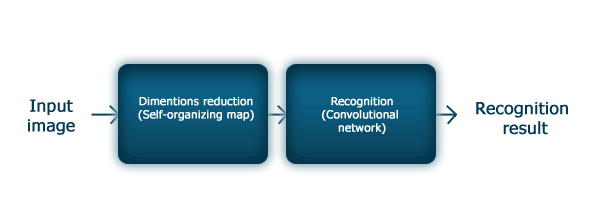Abstract " The investigation of the convolution neural network programming model for human faces pattern recognition "
Introduction
Nowadays biometric identification system become more and more widespread. People recognition of images of their faces stands out among biometric systems because it do not require special or expensive equipment, and, secondly, do not need direct contact of the person with the device.
In general, the problem of identification consists of two phases. The first consists of the finding and locating the person in the image, and then it is followed by the identification process. The implementation of these steps depends on the application. For example, there are systems for finding the person in a large database and then displaying a list of the most similar to humans. There is also a class of systems which identify a specific person in real time (security systems, access control systems)[1].
At the moment the problem of recognition of human face image has been widely discussed, but in general it is still far from being solved. The main difficulty is to recognize human faces on the image regardless of angle, position, lighting conditions, etc.
To solve the problem of face recognition have been proposed various methods, among which are approaches based on neural networks. Special attention should be a new approach to pattern recognition using convolutional neural networks.
The goals that must be achieved
The aim of the research is to evaluate the performance of convolutional neural networks in the case of human faces image recognition, to construct the software model of convolution neural network.
The following tasks should be done:
- Construction of the structure of face recognition based on the convolutional neural network
- Creation of the structure of convolutional neural network, choosing the teaching methods and learning set.
- Image preprocessing module construction using Kohonen self-organizing map;
- Creation of a software model of the human faces recognition system, which would demonstrate the process of learning and recognition, and allow to study learning process of the convolutional neural network.
Relevance of the topic
Nowadays biometric identification systems for people are becoming more and widespread. Their main advantages over traditional methods of identification are the follows: they are based on the unique biological characteristics, and, consequently, they are extremely difficult to forge.
The main difficulties to be overcome is to ensure the independence of the system on such factors as lighting, camera angle, as well as age-related changes. Many of the methods include a large and costly phase of preprocessing. However, without an understanding of some general image semantics it is difficult to do it properly.
Neural network methods are a new promising methods. The principle of such methods is based on the principle of the human brain. They are using the training to find the relationship between individual characteristics and perform image recognition with sufficient accuracy.
Expected practical results
After finishing the work it is planned to obtain a working program project designed for image recognition of human faces from a selected set.
It is also planned to do a comprehensive study of the programming model based on the convolutional neural network during training and recognition.
The theory of convolutional neural networks
Convolution neural network is a special class of the neural networks, which is well suited for intelligent processing of visual data. The idea of convolutional neural networks lies in the alternation of convolutional layers (C-layers), subsampling layers (S-layers) and the presence of fully connected (F-layers) layers on the output. They combine three architectural ideas to achieve invariance to shifting and distorting of the original image: the local field of perception, shared weights and spatial subsampling [5].
Incoming input image is subjected to convolution with some kernel of convolution [4] .
A convolutional layer is a layer of averaging and subsampling, which reduces the dimensions of the card features by lowering the sensitivity of outputs to the shifts and rotations.
This alternation of convolutional and subsempling layers leads to a gradual increase in the number of cards signs and a decrease of their dimensions from layer to layer [3].
To train the convolutional network a back propagation algorithm is usually used [2].
The structure of the recognition system is shown in figure 1 below.

Figure 1 — Recognition system
Recognition system based on the convolution of the neural network has several modules. It’s first module splits the image and than redudes it’s dimentions with the help of the self-organizing map. The second module uses a convolutional neural network for recognition.
Conclusion
For the time this article is written the structure of face recognition system is created and it’s software implementation is almost finished. A convolutional neural network topology is made and a learning set for it is picked up. This learning set, with sufficient representativeness, is the ORL Database of Faces. Also, the first version of the programming model of a convolutional neural network and image preprocessing module based on self-organizing maps of Kohonen are created.
In the future we plan to improve the programming model and study the influence of parameters of convolution neural network architecture for learning and recognition.
References
- Дзюба В. Г. Анализ методов распознавания лиц / Ю. И. Якименко, В. Г. Дзюба // Электроника и связь. — 2003. — № 20. — С. 149–152.
- Moody J., Darken C.J. Fast Learning In Netwoks of Locally TunedProcessing Units // Neural Computation. — 1989. — № 1. — P . 281–284.
- LeCun Y. Generalization and network design strategies // Proc. Of the Intern. Conf. Connectionism in Perspective. — University of Zurich, 10–13 October 1988. — P . 143–155.
- Макаренко А.А. Сверточные нейронные сети в задаче классификации изображений // Информационные системы. Вып. 4.: Тр. постоянно действующего научно-техн. семинара. Томск: Изд-во Том. гос. ун-та систем управления и радиоэлектроники, 2006. С. 3‑9.
- Lawrence S., Giles C. L., Tsoi A. C. and Back A. D. Face recognition:a convolutional neural network approach// IEEE Trans. on Neural Networks.- Special Issue on Neural Networks and Pattern Recognition.- 1997.- P.97-113.
